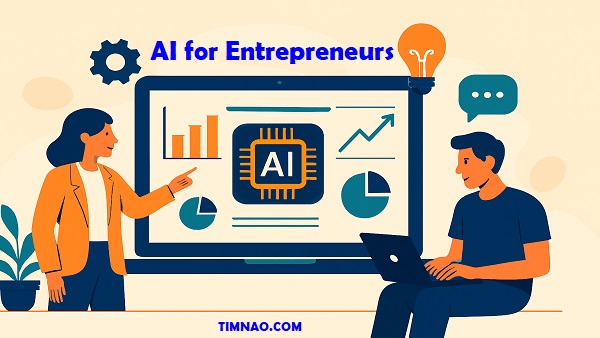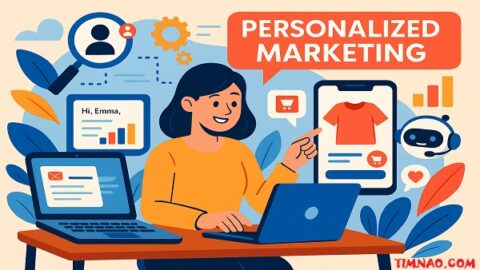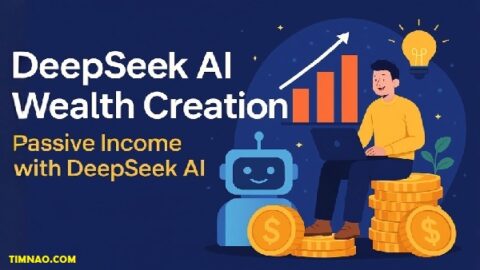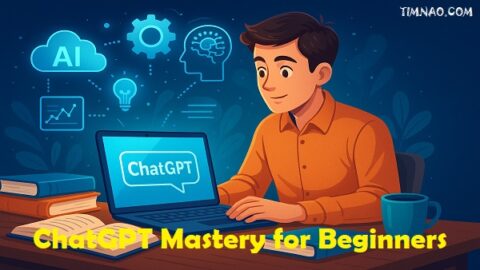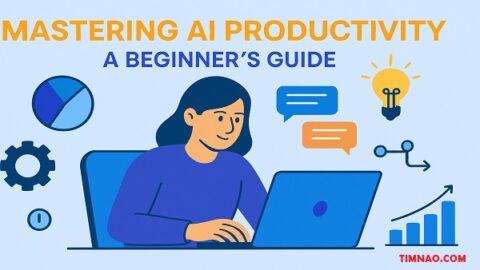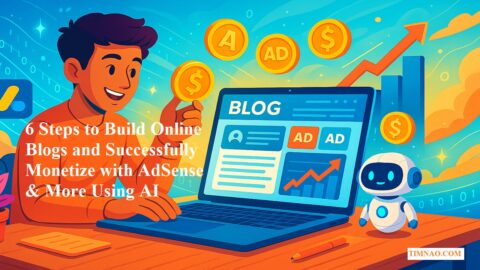Unlock Explosive Growth: Powerful AI Business Strategies Every Entrepreneur Needs 🚀
AI for Entrepreneurs is no longer a futuristic idea — it’s a present-day game-changer. From automating repetitive tasks to unlocking data-driven insights, AI is giving business owners of all sizes the power to grow faster, serve customers better, and work smarter instead of harder.
Whether you’re a solo entrepreneur looking to save hours each week, a small business owner aiming to scale without ballooning costs, or a startup founder ready to outpace competitors, AI can be your most valuable business partner. The best part? You don’t need to be a tech wizard to get started.
In this guide, we’ll explore practical ways you can use AI to boost productivity, drive sales, and streamline operations. You’ll discover beginner-friendly tools, real-world examples, and actionable steps to help you adopt AI confidently — even if you’ve never used it before. By the end, you’ll have a clear roadmap to integrate AI into your business and start seeing results within weeks.
Table of Contents
- 🚀 The AI Revolution in Entrepreneurship
- 🧠 Understanding AI Basics for Beginners
- 🎯 Finding High-Impact AI Opportunities in Your Business
- ⚙️ Essential AI Tools Every Entrepreneur Should Know
- 📈 Building AI-Driven Sales Funnels & Marketing Automation
- 🛠 Streamlining Operations with AI
- 📊 Data-Driven Decisions with AI Analytics
- 🚀 Scaling Your Business Using AI
- 🛡 Overcoming AI Adoption Barriers
- 🔮 Future AI Trends Entrepreneurs Must Watch
- ✅ Taking Action: Your AI Success Roadmap
🚀 The AI Revolution in Entrepreneurship
Artificial Intelligence (AI) is no longer a futuristic concept reserved for tech giants — it’s a business powerhouse reshaping the way entrepreneurs launch, grow, and scale companies. From automating customer support to predicting market trends, AI is giving business owners tools that were once available only to corporations with million-dollar budgets.
The true magic of AI lies in its ability to save time, cut costs, and uncover opportunities that humans often overlook. Imagine if your marketing campaigns could run themselves, your website could speak directly to each visitor’s needs, and your inventory could restock itself before running out. That’s not science fiction — it’s the reality for entrepreneurs embracing AI in 2025.
Across industries, AI is making a measurable impact:
- Retail & eCommerce – AI-driven recommendation engines (like Amazon’s) suggest products tailored to each customer, increasing sales and improving satisfaction.
- Healthcare – Startups are using AI to detect diseases earlier and provide personalized treatment plans.
- Finance – AI-powered fraud detection prevents losses before they happen.
- Marketing – AI tools optimize ad targeting, automatically create content, and send personalized emails at the perfect time.
For entrepreneurs, the competitive landscape has never been more intense. Early AI adopters are finding it easier to scale faster, operate leaner, and deliver exceptional customer experiences. Those who ignore AI risk being left behind by more agile, tech-savvy competitors.
Beginner Action Step:
List three time-consuming or repetitive tasks in your business right now. Search for AI tools that can automate just one of them this month. Even small wins can free up hours for higher-value work.
🧠 Understanding AI Basics for Beginners
If AI feels overwhelming, you’re not alone. The good news is you don’t need a computer science degree to use it effectively in your business. At its core, AI is simply about teaching machines to mimic certain types of human thinking — learning from data, recognizing patterns, and making decisions.
Here are the four main AI components every entrepreneur should know:
1. Machine Learning (ML)
Machine Learning allows AI systems to “learn” from data and get better over time without being explicitly reprogrammed.
Example: A subscription box business uses ML to analyze past purchases and predict which products subscribers are most likely to love next month.
2. Natural Language Processing (NLP)
NLP enables machines to understand and respond to human language — both written and spoken.
Example: AI chatbots like ChatGPT or Tidio can answer customer queries instantly, draft marketing emails, or even translate product descriptions into multiple languages.
3. Automation
AI automation handles repetitive tasks so humans can focus on creative and strategic work.
Example: An AI-powered email marketing tool sends personalized welcome messages to new leads without any manual effort.
4. Computer Vision
Computer vision lets AI interpret images and videos.
Example: Retailers use it to identify low-stock shelves in real time, while fitness apps use it to correct workout posture through smartphone cameras.
Why AI Works So Well for Entrepreneurs
- Saves Time: AI works around the clock without fatigue.
- Cuts Costs: Reduces the need for large support teams.
- Improves Accuracy: Less human error in repetitive tasks.
- Personalizes Experiences: Creates marketing, product, and service recommendations tailored to each customer.
Pro Tip: You don’t need to implement all AI components at once. Start with one — like AI-powered marketing or customer service — and expand gradually as you see measurable results.
Quick Start Checklist for AI Beginners:
- Pick a problem – What’s slowing your business down?
- Research an AI tool – Look for beginner-friendly, affordable options with free trials.
- Test small – Try one process automation first.
- Track results – Measure time saved, sales increased, or costs reduced.
- Expand – Apply AI to other areas as confidence grows.
🎯 Finding High-Impact AI Opportunities in Your Business
Artificial Intelligence can transform almost any business process — but that doesn’t mean you should try to apply it everywhere at once. The most successful entrepreneurs start by targeting high-impact areas where AI can create immediate value, save time, or unlock new revenue streams.
The key is to focus on three things:
- Repetitive tasks that eat up your time.
- Data-heavy decisions that can be optimized.
- Bottlenecks that slow your business down.
1. Spot the Time Wasters
If you find yourself or your team doing the same thing every day — answering identical customer questions, scheduling posts, manually tracking sales — AI can step in.
Example:
A handmade jewelry seller was spending 10 hours a week answering product questions on Instagram. By using ManyChat to automate responses to FAQs, she freed up that time to design new collections.
Beginner Action Step:
List the top three tasks you repeat most often. Search for AI tools that can automate at least one of them this week.
2. Look for Data-Driven Decisions
If your business relies on analyzing large amounts of data — from sales reports to website traffic — AI can help you make better decisions faster.
Example:
A small fitness studio used Google Analytics 4 to see which ad campaigns brought in the most sign-ups. The AI-driven insights allowed them to double their ad ROI in just one month.
Pro Tip:
Even if you don’t collect a lot of data yet, you can use AI to start tracking important metrics and build a habit of data-based decision-making.
3. Identify Your Bottlenecks
Every business has pain points — maybe your customer support queue is always full, your stock management is messy, or your lead follow-up is slow. These are prime candidates for AI.
Example:
A small clothing store used Inventory Planner to predict which items would sell out first. As a result, they reduced stockouts by 35% and increased overall revenue.
Beginner Action Step:
Write down your top two operational headaches. Ask: “If I could make this faster or easier, how would it affect my revenue or customer satisfaction?” Then explore AI tools designed for that area.
High-Impact AI Use Cases for Entrepreneurs
Here are some practical areas where AI can deliver quick wins:
- Marketing:
- Automate email campaigns with ActiveCampaign.
- Use AI ad optimization with Adzooma to improve targeting.
- Generate blog and social content with Jasper AI.
- Sales:
- Qualify leads with AI chatbots like Tidio.
- Use HubSpot AI for predictive lead scoring.
- Automate abandoned cart recovery with Klaviyo.
- Customer Service:
- Offer 24/7 support using Zendesk AI.
- Analyze customer sentiment with MonkeyLearn.
- Operations & Logistics:
- Forecast demand with Blue Yonder.
- Optimize delivery routes with OptimoRoute.
Measuring the Potential ROI of AI Investments
Before you commit to a new AI tool, ask:
- How much time will this save per week?
- Will it reduce costs or increase revenue?
- How quickly can I see results?
Example ROI Check:
If your customer service team spends 15 hours a month answering repetitive questions and their time is worth $20/hour, that’s $300 monthly. If an AI chatbot costs $50/month and can handle 80% of those queries, you’re effectively saving $250 right away.
Quick Start for Beginners
- Pick one business function — marketing, sales, customer service, or operations.
- Find the biggest time drain or bottleneck.
- Choose a simple AI tool with a free trial.
- Test for 2-4 weeks and measure results.
- Expand gradually based on the biggest ROI.
Key Takeaway:
You don’t need to “AI-ify” your entire business overnight. Start with the one area where the payoff will be highest, prove the value, and then expand. This targeted approach ensures AI becomes a profit driver, not just a shiny new tool.
⚙️ Essential AI Tools Every Entrepreneur Should Know
Once you’ve identified where AI can make the biggest impact, the next step is choosing the right tools. The market is flooded with AI-powered platforms, but not all of them will suit your needs. The best AI tools for entrepreneurs are the ones that save time, simplify complex tasks, and directly improve revenue or customer experience.
To make it easier, here’s a curated list of AI tools grouped by business function — each with beginner-friendly use cases and quick-start tips.
📝 AI for Content Creation & Copywriting
High-quality content is essential for attracting and converting customers, but producing it consistently can be time-consuming. AI writing assistants help you create blogs, ads, product descriptions, and social media posts in minutes.
Top Picks:
- ChatGPT – Generates human-like text for blogs, FAQs, emails, and scripts.
- Jasper AI – Specializes in marketing copy, ad headlines, and conversion-focused content.
- Copy.ai – Great for brainstorming, email subject lines, and product descriptions.
Example Use Case:
A small online course creator uses Jasper AI to write weekly promotional emails, saving 8–10 hours of writing time each month.
Beginner Tip: Start by using AI to create first drafts, then refine them with your own brand voice.
🎨 AI for Visual Design & Branding
You don’t have to be a professional designer to produce eye-catching graphics. AI design tools can help you create brand assets, social media visuals, and even product mockups in minutes.
Top Picks:
- Canva – AI-assisted templates for presentations, social posts, and marketing materials.
- Midjourney – Generates unique, artistic images for branding or ads.
- Leonardo AI – Creates custom product designs, illustrations, and promotional images.
Example Use Case:
An Etsy seller uses Midjourney to generate unique art for print-on-demand merchandise, cutting design costs by 80%.
📢 AI for Marketing Automation
AI marketing platforms can personalize campaigns, segment your audience, and deliver the right message at the right time — all without manual input.
Top Picks:
- ActiveCampaign – AI-driven email marketing and CRM automation.
- ConvertKit – Perfect for creators and coaches looking to automate email funnels.
- HubSpot AI – Combines marketing, sales, and customer service automation in one platform.
Example Use Case:
A fitness coach uses ActiveCampaign’s AI to send customized workout plans based on each subscriber’s goals.
Pro Tip: Start with one automated email sequence, such as a welcome series for new leads.
💼 AI for Sales Funnels & Lead Generation
AI sales tools help you attract, qualify, and convert leads with minimal effort.
Top Picks:
- ClickFunnels – Build automated, high-converting sales funnels.
- Unbounce – Uses AI to optimize landing page layouts for higher conversions.
- Leadpages – Simple landing page creation with built-in conversion tools.
Example Use Case:
A SaaS startup uses Unbounce’s Smart Traffic AI to deliver different landing page versions to different audiences, boosting conversions by 25%.
📊 AI for Business Analytics & Insights
Data is your most valuable asset, but raw numbers can be overwhelming. AI analytics tools turn data into clear insights you can act on immediately.
Top Picks:
- Google Analytics 4 – Tracks website traffic, conversions, and user behavior with AI-driven recommendations.
- Hotjar – Uses heatmaps to show exactly where visitors click, scroll, and exit.
- Mixpanel – Analyzes customer engagement and retention, especially useful for SaaS and mobile apps.
Example Use Case:
An eCommerce store uses Hotjar to discover that most users abandon their cart on the shipping page, prompting them to offer free shipping — which increases conversions.
📅 AI for Productivity & Workflow Automation
AI can connect your favorite apps, schedule tasks, and manage workflows without constant human input.
Top Picks:
- Zapier – Links multiple apps so data flows automatically between them.
- Make – Visual workflow builder for more complex automation sequences.
- Reclaim AI – Automatically schedules meetings, focus time, and recurring tasks.
Example Use Case:
A digital agency uses Zapier to automatically send new Facebook leads into its CRM, saving hours of manual entry.
🔍 How to Choose the Right AI Tools for Your Business
When evaluating an AI tool, ask yourself:
- Does it solve a specific problem I have right now?
- Is it easy to integrate with my current systems?
- Can I try it for free before committing?
- Will the time or money saved outweigh the subscription cost?
Beginner Action Step:
Pick one business area (marketing, sales, or operations) and try one AI tool for 2–4 weeks. Track the results — if you see a measurable benefit, expand from there.
Key Takeaway:
The best AI tools are not the ones with the most features, but the ones that fit seamlessly into your workflow and deliver measurable results. Start small, focus on ROI, and build an AI tool stack that grows with your business.
📈 Building AI-Driven Sales Funnels & Marketing Automation
A sales funnel is the journey your customers take — from discovering your brand to becoming loyal buyers. The problem? Managing every step manually is time-consuming and often inconsistent. That’s where AI-powered sales funnels and marketing automation come in.
With AI, you can create a funnel that works 24/7: attracting leads, nurturing them with personalized content, and converting them into paying customers — all while you focus on other parts of your business.
🎯 How AI Enhances Every Stage of the Sales Funnel
AI can supercharge your funnel by improving personalization, timing, and efficiency at each stage.
1. Awareness Stage (Attracting Potential Customers)
- AI-Powered Content Creation: Use tools like Jasper AI or Copy.ai to write blog posts, ad copy, and social media captions that match your target audience’s interests.
- Ad Targeting with AI: Platforms like Adzooma optimize your ad spend by automatically adjusting targeting based on performance data.
- SEO Optimization: AI-driven tools like Surfer SEO help create keyword-rich articles that rank higher on Google.
Example:
A small skincare brand used AI to create blog posts answering customer skin concerns. These articles ranked on Google, bringing in 2,000 monthly visitors without paid ads.
2. Interest Stage (Engaging Potential Customers)
- AI Chatbots: Tools like Tidio answer questions instantly and suggest relevant products.
- Personalized Lead Magnets: AI can recommend the best type of free offer (e.g., eBook, webinar, discount) based on audience behavior.
- Dynamic Landing Pages: Platforms like Unbounce use AI to show different headlines and offers to different visitors.
Example:
A fitness coach created two landing page versions — one for weight loss clients, another for muscle gain. AI automatically displayed the right version based on visitor interests, increasing sign-ups by 35%.
3. Decision Stage (Converting Leads into Customers)
- Email Personalization: AI platforms like ActiveCampaign tailor email content to each subscriber’s behavior.
- Predictive Analytics: HubSpot AI predicts which leads are most likely to buy and prioritizes them for follow-up.
- AI Product Recommendations: E-commerce platforms like Shopify can display “frequently bought together” items to boost cart value.
Example:
An online store used Shopify’s AI product suggestions to upsell matching accessories — increasing average order value by 20%.
4. Retention Stage (Turning Customers into Repeat Buyers)
- AI Loyalty Programs: Tools like Smile.io automate rewards based on purchase history.
- Customer Sentiment Analysis: MonkeyLearn scans reviews to spot unhappy customers early.
- Re-Engagement Campaigns: AI can trigger win-back emails when customers go inactive.
Example:
A coffee subscription brand used AI to detect when customers skipped two shipments. It then sent a personalized discount offer, winning back 40% of those customers.
🛠 Step-by-Step: Building Your First AI-Driven Sales Funnel
- Define Your Funnel Goal
Decide whether you want more leads, more sales, or higher repeat purchases. - Choose Your AI Tools
- Content: Jasper AI, Canva
- Ads: Adzooma
- Landing Pages: Unbounce
- Email: ActiveCampaign
- Create Targeted Content
Use AI to write blog posts, design ads, and create lead magnets. - Set Up Automated Workflows
Connect your landing pages to your email marketing platform. Use AI to segment your audience automatically. - Test & Optimize
Use A/B testing with AI tools to improve conversion rates. - Track ROI
Measure time saved, leads generated, and sales closed.
🚀 Beginner Quick Wins for AI Funnels
- Automate your welcome email series to make a great first impression.
- Use AI to send product recommendations based on customer browsing history.
- Implement cart abandonment automation to recover lost sales.
- Test dynamic pricing tools that adjust offers based on demand and customer behavior.
Key Takeaway:
An AI-driven sales funnel doesn’t just save you time — it helps you convert more leads into paying customers by delivering the right message to the right person at the right time. Start small, automate one stage of your funnel, and build from there.
🛠 Streamlining Operations with AI
Running a business means juggling countless moving parts — from managing inventory to processing orders and coordinating teams. Without the right systems, these operational tasks can eat up your time and slow growth. AI changes the game by automating repetitive processes, reducing errors, and making your workflow faster and smarter.
Think of AI as your behind-the-scenes operations manager, working 24/7 to keep everything running smoothly.
📦 Inventory & Supply Chain Management
AI can predict demand, prevent stockouts, and optimize your entire supply chain.
Top Tools:
- Inventory Planner – Forecasts sales trends and recommends reorder points.
- Blue Yonder – AI-powered supply chain optimization for retailers and manufacturers.
- StockTrim – Ideal for small businesses looking to automate stock planning.
Example:
A small cosmetics brand used AI demand forecasting to predict holiday sales, ordering stock in advance. As a result, they avoided both overstocking and losing sales due to shortages.
💬 Customer Support Automation
Handling customer questions manually can slow down response times. AI-powered customer service tools help you respond instantly and consistently.
Top Tools:
- Zendesk AI – Automates ticket routing and suggests replies.
- Tidio – Combines live chat and AI chatbots for small businesses.
- Freshdesk – Uses AI to prioritize urgent tickets and recommend solutions.
Example:
An online clothing store set up an AI chatbot to handle 70% of common inquiries. Support staff could then focus on complex issues, reducing response time by 60%.
📑 Document & Workflow Automation
From contracts to invoices, AI can handle your routine paperwork in seconds.
Top Tools:
- DocuSign – Automates digital contracts with AI-assisted error checking.
- Make – Builds visual workflows that connect multiple apps without coding.
- Zapier – Sends data between your tools automatically.
Example:
A consultancy connected its CRM, invoicing, and email systems with Zapier, cutting admin time by 10 hours per month.
🗂 Project & Task Management
AI project management tools keep your team aligned, predict delays, and recommend task priorities.
Top Tools:
- Asana with AI Work Graph – Suggests priorities and automates recurring tasks.
- ClickUp – Uses AI to summarize project updates and generate reports.
- Trello with AI Power-Ups – Adds automation to task boards.
Example:
A digital marketing agency used ClickUp’s AI to summarize client updates into concise weekly reports, freeing project managers from hours of manual writing.
📊 Financial Management & Accounting
AI-driven finance tools can track expenses, manage invoices, and even predict cash flow issues.
Top Tools:
- QuickBooks Online – AI categorizes expenses and automates invoicing.
- Xero – Provides cash flow forecasting with AI insights.
- Fathom – Delivers AI-driven business performance analytics.
Example:
A freelance designer used QuickBooks to automatically sort expenses and generate tax-ready reports, saving hours during tax season.
📋 Before & After AI: Operations Transformation
| Task | Before AI | After AI |
|---|---|---|
| Customer Support | Manual responses taking 2-3 days | AI chatbot responds instantly |
| Inventory Planning | Guessing reorder quantities | AI forecasts based on sales data |
| Invoicing | Manually created and sent | Automated, sent instantly |
| Project Updates | Hours writing reports | AI generates summaries in minutes |
| Expense Tracking | Manual spreadsheet entry | AI auto-categorizes expenses |
🚀 Quick Start for Beginners
- Pick one operational area — customer support, inventory, or finance.
- Choose one AI tool that solves your biggest bottleneck.
- Integrate it into your existing workflow without changing everything at once.
- Test for 30 days and track time saved or errors reduced.
- Expand gradually to other operational areas.
Key Takeaway:
Streamlining operations with AI doesn’t just save time — it also reduces stress, improves accuracy, and frees you up to focus on growth. Start with your biggest operational headache, let AI handle it, and scale from there.
📊 Data-Driven Decisions with AI Analytics
In business, guessing is expensive. The most successful entrepreneurs make decisions based on accurate, real-time data — and that’s exactly where AI analytics shines. Instead of drowning in spreadsheets or struggling to interpret numbers, AI turns raw data into clear, actionable insights you can use immediately.
Whether you want to understand customer behavior, track marketing performance, or forecast sales, AI analytics helps you make smarter, faster, and more profitable decisions.
🔍 Why AI Analytics Beats Traditional Reporting
Traditional data analysis is often slow and limited. You gather data, send it to an analyst, wait for a report, and hope it’s still relevant by the time you read it.
AI changes that by:
- Analyzing in real time so you can react instantly.
- Spotting patterns humans might miss.
- Predicting outcomes based on historical and current data.
Example:
An online subscription box service used AI analytics to notice that customers who skipped two consecutive shipments were highly likely to cancel. They quickly launched targeted retention campaigns — saving 30% of at-risk subscribers.
📈 Key Areas Where AI Analytics Creates Value
1. Customer Insights
AI can segment customers based on behavior, preferences, and purchase history.
Tools to Try:
- Google Analytics 4 – Tracks traffic, conversions, and user paths with AI insights.
- Mixpanel – Focused on user behavior and engagement.
- Hotjar – Visualizes clicks, scrolls, and navigation patterns.
Beginner Action Step:
Check which pages on your site keep visitors the longest — then create more content in that style.
2. Marketing Performance
AI can pinpoint which campaigns bring the best ROI and where your ad spend is wasted.
Tools to Try:
- HubSpot AI – Tracks campaign performance and predicts lead quality.
- Adzooma – Optimizes ad budgets across platforms.
- Surfer SEO – Analyzes top-ranking content and gives step-by-step improvement tips.
Example:
A small SaaS company used AI ad optimization to shift budget from underperforming Facebook ads to high-converting Google ads, doubling sign-up rates.
3. Sales Forecasting
AI models can predict future sales trends, helping you plan inventory, staffing, and marketing pushes.
Tools to Try:
- Fathom – Financial forecasting for small businesses.
- Inventory Planner – Demand forecasting for eCommerce.
- Klaviyo – Predicts customer lifetime value and purchase timing.
Beginner Tip:
Start with 3–6 months of historical sales data to train your AI tool for better accuracy.
4. Risk Management
AI can detect unusual patterns that signal fraud, supply chain issues, or sudden drops in engagement.
Tools to Try:
- Darktrace – AI cybersecurity that flags suspicious activity.
- MonkeyLearn – Analyzes reviews and social media for negative sentiment spikes.
- RapidMiner – Advanced predictive modeling for various risks.
Example:
An online store noticed a sudden spike in failed transactions. AI flagged it as a possible payment processor error, allowing them to fix it before losing more sales.
📊 The “Ask, Analyze, Act” Framework for Beginners
- Ask – Define a specific business question (e.g., “Which product brings the highest profit margin?”).
- Analyze – Use AI analytics tools to gather insights and visualize the results.
- Act – Make data-backed changes, then measure results to confirm improvement.
📋 Before & After AI Analytics: Decision-Making Impact
| Area | Before AI | After AI |
|---|---|---|
| Marketing Spend | Budget spread evenly | Budget shifted to high-ROI channels |
| Customer Insights | Basic demographics | Detailed behavior-based segments |
| Sales Planning | Manual, guesswork | Accurate, AI-powered forecasting |
| Risk Detection | Reactive response | Proactive alerts before problems escalate |
🚀 Quick Start for AI Analytics
- Pick one decision you want to make this month (e.g., best ad platform).
- Choose one AI analytics tool with a free trial.
- Connect your data sources (website, ads, sales).
- Review the insights and take one immediate action.
- Track the results for 30 days.
Key Takeaway:
AI analytics doesn’t just give you more data — it gives you the right data at the right time. By acting on these insights, you can reduce wasted effort, seize opportunities faster, and make every decision count toward your growth.
🚀 Scaling Your Business Using AI
Starting a business is one thing. Growing it into a thriving, profitable operation is another. Scaling means increasing your revenue and reach without a matching increase in costs or workload — and AI makes that possible faster than ever.
By automating tasks, personalizing customer interactions, and unlocking new revenue streams, AI helps you scale strategically instead of chaotically.
📈 Why AI Is the Ultimate Growth Partner
Traditional growth often means hiring more staff, spending more on ads, and adding more hours to your workweek. AI flips this model by:
- Reducing operational bottlenecks through automation.
- Expanding customer reach with intelligent targeting.
- Making smarter, faster decisions using real-time analytics.
- Unlocking new product or service possibilities with AI innovation.
Example:
A boutique marketing agency scaled from 10 to 50 clients in one year without hiring additional staff — simply by using AI for content creation, campaign management, and analytics.
🔑 Core Areas Where AI Accelerates Scaling
1. Customer Acquisition at Scale
AI advertising platforms can identify and target your most valuable prospects across multiple channels automatically.
Tools to Try:
- Adzooma – Optimizes ad spend in real time.
- Albert AI – Fully autonomous digital marketing campaigns.
- HubSpot AI – Tracks leads from first touch to conversion.
Beginner Tip:
Start with one platform and one audience segment. Let AI refine targeting before expanding to new markets.
2. Personalization Without Limits
AI can tailor experiences for thousands of customers simultaneously — something impossible to do manually.
Tools to Try:
- Klaviyo – Sends personalized email campaigns based on browsing and purchase history.
- Dynamic Yield – Adjusts website content in real time to match each visitor.
- Tidio – Provides instant, personalized chatbot responses.
Example:
An eCommerce store used AI to recommend products based on browsing patterns, boosting average order value by 25%.
3. Global Expansion Made Simple
AI translation and localization tools allow you to reach customers in different countries without hiring a full translation team.
Tools to Try:
- DeepL – High-quality translations for websites and marketing content.
- Weglot – Automatically translates and adapts websites for international markets.
- Lokalise – Manages translation workflows for apps and software.
Example:
A software startup translated its landing page into five languages with Weglot, opening up new markets and increasing sales by 40% in three months.
4. Product & Service Innovation
AI can help you identify gaps in the market and create new offerings quickly.
Tools to Try:
- ChatGPT – Idea generation for new products or services.
- Midjourney – Concept visualization for prototypes.
- Synthesia – Creates AI-powered training videos or product demos.
Beginner Action Step:
Ask AI tools to analyze customer feedback and suggest product improvements or complementary services.
🛠 The AI Scaling Blueprint for Beginners
- Automate Your Foundations – Use AI to handle repetitive tasks like emails, invoicing, and scheduling.
- Double Down on What Works – Use AI analytics to identify your best-performing products or campaigns.
- Expand Reach – Test AI-driven ads or localization tools to tap into new markets.
- Innovate Continuously – Let AI help you brainstorm and test new offers.
- Measure & Adjust – Track performance and refine strategies based on AI insights.
📋 Before & After Scaling with AI
| Stage | Before AI | After AI |
|---|---|---|
| Lead Generation | Manual targeting | AI identifies high-value leads automatically |
| Marketing Reach | Limited by team capacity | Automated, multi-channel campaigns |
| Customer Support | Reactive & slow | 24/7 AI chatbots with instant responses |
| Market Expansion | High translation costs | Automated localization in days |
🚀 Quick Wins to Start Scaling with AI
- Use AI ads to target “lookalike” audiences similar to your best customers.
- Implement an AI chatbot to handle FAQs and pre-sale inquiries.
- Translate your top-performing sales page into at least two new languages.
- Create automated upsell offers at checkout to increase order value.
Key Takeaway:
Scaling isn’t about working harder — it’s about working smarter. By letting AI handle the heavy lifting, you can grow your business faster, serve more customers, and explore new opportunities without stretching your resources too thin.
🛡 Overcoming AI Adoption Barriers
AI can unlock massive growth opportunities for your business — but adopting it isn’t always smooth sailing. Many entrepreneurs face challenges like limited budgets, lack of technical skills, and uncertainty about where to start. The good news? Most of these barriers can be overcome with the right approach.
Think of AI adoption as upgrading your business toolbox — you don’t need to master every tool on day one, but you do need a plan to start using them effectively.
🚧 Common Barriers to AI Adoption — and How to Overcome Them
1. “It’s Too Expensive”
Many business owners think AI requires a massive budget. While enterprise-level AI systems can be costly, there are plenty of affordable or even free tools designed for small businesses.
Solution:
- Start with freemium tools like ChatGPT, Canva, or Tidio.
- Test low-cost AI platforms with monthly subscriptions before committing long-term.
- Calculate ROI by tracking time saved or revenue generated — this often proves AI pays for itself.
Example:
A handmade jewelry seller used Canva’s free AI-powered design tools to create social media posts, saving $300/month in outsourced design costs.
2. “I’m Not Tech-Savvy”
The thought of implementing AI can feel overwhelming if you don’t have a technical background. But most modern AI tools are no-code or require minimal setup.
Solution:
- Choose platforms with simple, user-friendly interfaces.
- Watch free tutorials on YouTube or join the tool’s community forums.
- Start with one use case, like AI-generated marketing copy, before expanding.
Example:
A bakery owner with no tech skills used Copy.ai to create weekly Facebook ads — increasing online orders by 20% in one month.
3. “What If It Replaces My Staff?”
Some worry that AI adoption means replacing employees. In reality, AI works best as a support system, freeing up staff to focus on higher-value work.
Solution:
- Involve your team in choosing and testing AI tools.
- Reframe AI as a “time-saving assistant” rather than a replacement.
- Provide training so employees can use AI to improve their own productivity.
Example:
A marketing team used AI to automate repetitive reporting, allowing them to spend more time on creative campaign strategies.
4. “I Don’t Know Where to Start”
With so many AI tools available, it’s easy to get stuck in “analysis paralysis.”
Solution:
- Identify your biggest business bottleneck (e.g., lead generation, customer service, inventory).
- Choose one AI tool that solves that problem.
- Run a 30-day test, measure results, and decide whether to expand.
Example:
A local gym struggling with low class attendance started with an AI-powered scheduling system. Attendance improved within weeks, proving the value of further AI adoption.
5. Data Privacy & Security Concerns
Handling customer data responsibly is critical. Some fear that using AI tools may compromise privacy.
Solution:
- Choose reputable AI vendors with clear security policies.
- Avoid sharing sensitive customer data with tools that don’t guarantee protection.
- Learn the basics of GDPR and local data privacy laws to stay compliant.
Example:
An online store using AI chatbots anonymized customer details before processing — keeping both compliance and customer trust intact.
🗺 A Simple 5-Step AI Adoption Plan for Beginners
- Identify the Pain Point – Focus on one area where you lose the most time or money.
- Research AI Solutions – Compare 2–3 tools designed for that problem.
- Test with a Small Budget – Use free trials or low-cost plans.
- Train Your Team – Make sure everyone understands how to use the new tool.
- Measure & Optimize – Track results and refine your process before scaling.
💡 Pro Tips to Make AI Adoption Smoother
- Start Small, Win Big: Small wins build confidence in AI.
- Document Processes: Write down how you use each tool for easier team training.
- Stay Updated: AI evolves fast — set time each month to learn about new features.
- Leverage Communities: Join Facebook groups or LinkedIn communities focused on AI in business.
Key Takeaway:
Adopting AI doesn’t have to be intimidating or expensive. By starting small, focusing on real business needs, and involving your team, you can turn potential barriers into stepping stones for growth.
🔮 Future AI Trends Entrepreneurs Must Watch
AI isn’t just transforming business today — it’s shaping the next decade of entrepreneurship. Staying ahead of these trends can give you a first-mover advantage, allowing you to adapt faster, capture new markets, and outpace competitors.
The entrepreneurs who thrive in the future will be those who spot changes early and take action before the crowd.
🚀 1. AI-Driven Hyper-Personalization
Consumers increasingly expect experiences tailored just for them. AI will move beyond basic recommendations to create real-time, one-to-one personalization across every touchpoint.
Opportunities for Entrepreneurs:
- Create dynamic websites that adapt based on a visitor’s behavior.
- Use AI to personalize email sequences, offers, and even product designs.
- Develop niche products or services based on deep customer insights.
Example:
Imagine a fashion store where AI designs clothing patterns based on a customer’s personal style history — ready for production the same day.
🌐 2. AI + AR/VR Integration
Artificial Intelligence combined with Augmented Reality (AR) and Virtual Reality (VR) will create immersive shopping, training, and service experiences.
Opportunities for Entrepreneurs:
- Virtual try-ons for eCommerce.
- AI-driven VR training programs for businesses.
- AR product demos for retail and events.
Example:
A furniture store could use AI + AR to show customers how a sofa would look in their living room in real time — increasing purchase confidence.
🤖 3. Autonomous Business Processes
We’re heading toward businesses that can operate with minimal human intervention. AI will soon manage entire workflows — from lead generation to customer support — with human oversight instead of daily micromanagement.
Opportunities for Entrepreneurs:
- Build semi-autonomous online stores.
- Launch subscription services that run almost entirely on AI.
- Use AI agents for market research, outreach, and follow-up.
Example:
An eCommerce store could run marketing, fulfillment, and customer support 24/7 — with the owner focusing only on strategy.
📊 4. Predictive & Prescriptive Analytics
AI will shift from simply predicting what might happen to prescribing exact actions to achieve desired results.
Opportunities for Entrepreneurs:
- Use AI to recommend pricing adjustments in real time.
- Let AI suggest new products based on trending data.
- Apply prescriptive analytics for supply chain optimization.
Example:
A food delivery service could have AI dynamically adjust delivery zones and menus to maximize profit during peak hours.
♻️ 5. AI for Sustainability
Environmental responsibility is becoming a market advantage. AI will help entrepreneurs reduce waste, optimize energy use, and create sustainable products.
Opportunities for Entrepreneurs:
- AI-powered tools for supply chain sustainability.
- Energy optimization software for physical locations.
- Predictive models to reduce material waste.
Example:
A manufacturing startup could use AI to cut production waste by analyzing machine efficiency in real time.
🧠 6. AI-Enhanced Creativity
Far from replacing human creativity, AI will act as a creative partner, helping entrepreneurs brainstorm, design, and produce unique content at scale.
Opportunities for Entrepreneurs:
- AI-assisted book writing, video production, and music creation.
- Generating visual concepts for products or branding.
- Rapidly testing multiple creative campaigns before launch.
Example:
A solo entrepreneur could produce professional-quality video ads in hours — something that once took weeks and a full team.
🛡 7. Ethical & Regulatory AI
As AI adoption grows, so will regulations. Businesses will need to be transparent about how they use AI and how they handle customer data.
Opportunities for Entrepreneurs:
- Offer AI compliance consulting for small businesses.
- Build tools that make AI usage more transparent and accountable.
- Leverage ethical AI as a brand differentiator.
Example:
A digital agency could highlight that its AI marketing services follow strict privacy standards, appealing to privacy-conscious clients.
🚀 How to Stay Ahead of AI Trends
- Dedicate Learning Time – Spend at least one hour a week exploring new AI tools or features.
- Follow Industry Leaders – Keep up with AI news via platforms like TechCrunch or VentureBeat AI.
- Test Early – Be among the first to try emerging tools before they become mainstream.
- Join AI Communities – Engage in discussions on LinkedIn groups or niche AI forums.
- Keep Ethics in Mind – Build trust by being transparent about your AI usage.
Key Takeaway:
The future of entrepreneurship will be deeply intertwined with AI — not just as a tool, but as a core driver of innovation, customer experience, and market leadership. The sooner you start experimenting and adapting, the better prepared you’ll be to ride the next wave of opportunities.
✅ Taking Action: Your AI Success Roadmap
Learning about AI’s potential is exciting — but results only come when you take action. Too many entrepreneurs fall into “research mode,” endlessly exploring AI without ever putting it to work in their business.
This roadmap will help you move from curiosity to concrete results, one manageable step at a time.
🗺 Step 1: Define Your Vision
Before diving into tools, get crystal clear on what you want AI to achieve for your business.
Ask yourself:
- Do I want to save time on repetitive tasks?
- Do I want to increase sales or improve customer service?
- Am I looking to launch a new product or scale my operations?
Example:
A freelance designer might use AI to automate social media content creation, freeing up hours for client work.
⚙ Step 2: Start Small & Focused
You don’t need to overhaul your entire business in one go. Choose one area where AI can make an immediate impact.
Possible starting points:
- Automating customer inquiries with an AI chatbot.
- Using AI to analyze sales data for better pricing.
- Creating marketing visuals with AI design tools.
Beginner Tip:
Pick something that will give visible results within 30 days — quick wins build momentum.
📈 Step 3: Measure Your Results
AI adoption should be driven by clear, measurable outcomes.
Track metrics like:
- Time saved per week.
- Increase in leads or sales.
- Reduction in customer support response time.
Example:
If your AI chatbot handles 200 inquiries a month, calculate how much that would have cost in staff time.
📚 Step 4: Upskill as You Go
The more you understand AI, the more effectively you can use it. You don’t need to be a programmer — just AI-literate.
Ways to upskill:
- Follow AI-focused blogs and podcasts.
- Take free online courses like Google’s AI for Everyone.
- Join LinkedIn or Facebook communities for AI entrepreneurs.
🤝 Step 5: Involve Your Team
If you have a team, bring them into the AI journey early.
How to do it:
- Offer short training sessions.
- Assign one “AI Champion” to explore and test tools.
- Encourage staff to suggest areas where AI could help.
Example:
A small retail shop trained two staff members to use AI for inventory tracking, reducing stockouts by 40%.
🚀 Step 6: Scale What Works
Once you’ve seen success in one area, expand AI use gradually.
Scaling strategies:
- Integrate AI into multiple departments.
- Upgrade from free to paid plans for more features.
- Combine AI tools for more powerful workflows.
Example:
An online course creator started with AI-generated video scripts, then scaled to full AI-assisted course production and marketing automation.
🛡 Step 7: Review, Refine, Repeat
AI tools evolve quickly — what works today may be outdated in a year. Make ongoing evaluation part of your process.
Checklist for regular reviews:
- Are my AI tools still delivering ROI?
- Have new tools emerged that could work better?
- Is my team confident and skilled in using them?
🎯 Your AI Quick-Start Plan for the Next 30 Days
- Week 1: Pick one business problem AI could solve.
- Week 2: Test one AI tool designed for that problem.
- Week 3: Measure results and collect feedback.
- Week 4: Decide whether to expand, replace, or refine the tool.
By the end of one month, you’ll not only have hands-on AI experience — you’ll also know exactly how it impacts your business.
Key Takeaway:
Success with AI isn’t about mastering every tool or chasing every trend. It’s about starting small, acting consistently, and scaling what works. Every business — no matter the size — can benefit from AI, but the ones that win big are those that take the first step today, not “someday.”

